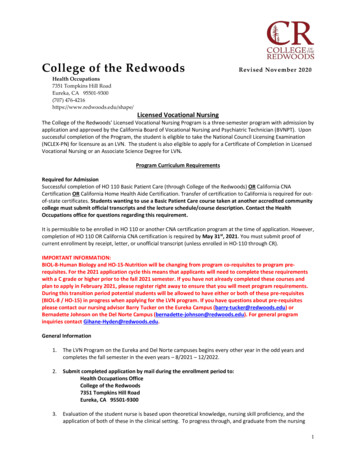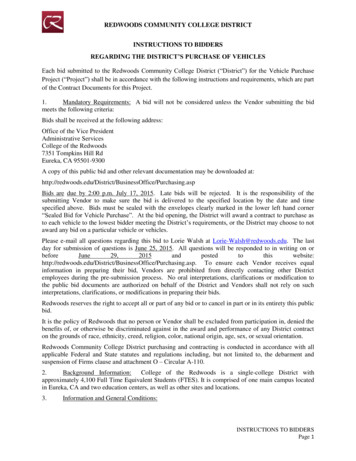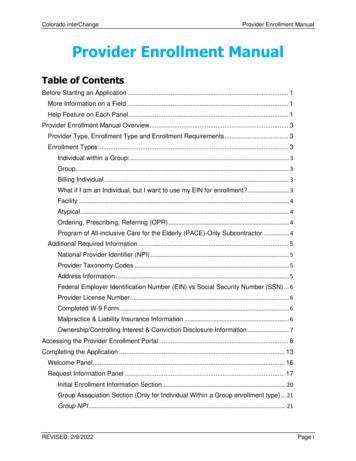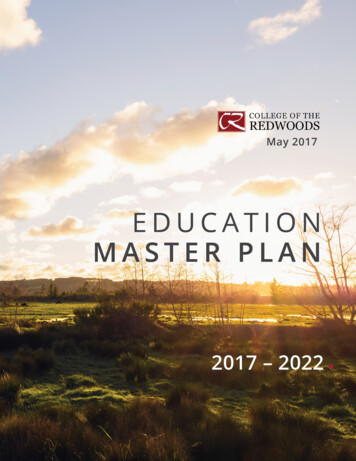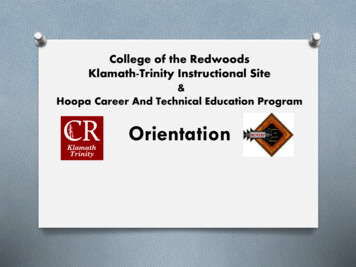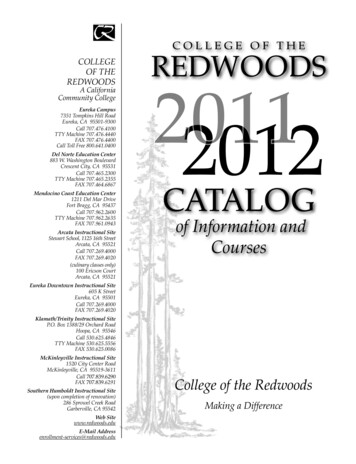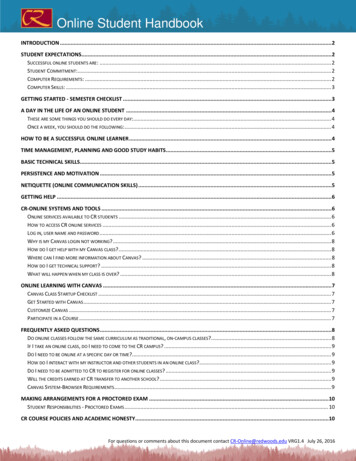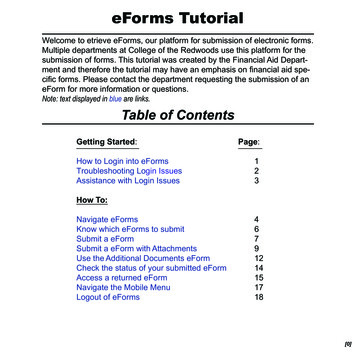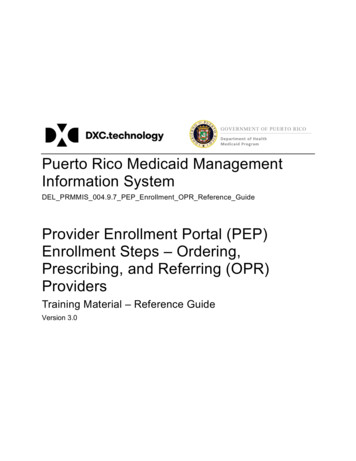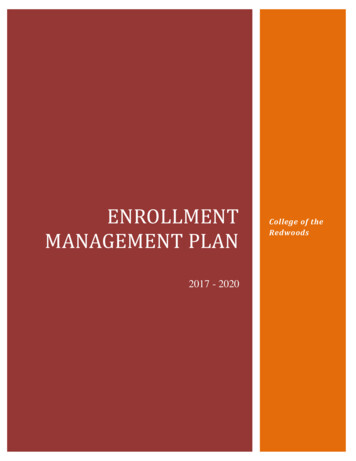
Transcription
ENROLLMENTMANAGEMENT PLAN2017 - 2020College of theRedwoods
Table of ContentsIntroduction .2Enrollment Management Plan Committee .2Mission .3Vision .3College History .3Enrollment Management Values .4Enrollment Trends.5Student Satisfaction with Student Services.9Strengths .9Weaknesses . 10Assessing Enrollment Management Efforts . 11Student Performance Goals . 11Access Goals . 11Phases of the Enrollment Cycle . 12Enrollment Management Plan . 13Enrollment Phase: Recruitment . 13Enrollment Phase: Initial Enrollment . 15Enrollment Phase: Persistence & Completion . 17Status of Past Enrollment Management Plan Actions. 19Status of 2013-14 Planning Activities . 19Status of Revised 2015-17 Planning Activities . 20Enrollment Management PlanPage 1
IntroductionThe 2017 – 2020 Enrollment Management Plan is a three-year evolving plan that includes goalsand strategies that are aligned to the College’s mission, Educational Master Plan, and integratedplanning. This evolving plan is intended to provide strategies for access and inclusiveness, andquality for the college and the students it serves. The 2017-2020 plan reflects the college’songoing enrollment management efforts. The work done towards the 2015-17 and 2013-14Enrollment Management Plans is included in this report, showing a history of advances.Enrollment Management Plan CommitteeIn support of the college's mission and strategic plan, the Enrollment Management Committeeanalyzes trends and uses data to recommend strategies to optimize enrollment. Among theEMC's responsibilities: Recommend strategies to meet and sustain enrollment targetsRecommend a comprehensive recruitment and retention plan; andRecommend purposeful linkage between marketing, recruitment, and branding.The EMC includes a cross sectional representation of employee groups and a studentrepresentative.The following committee members contributed to this plan.Angelina Hill, Vice President of Instruction & Student Development (Chair)Dave Bazard, Dean of Math, Science, Behavioral & Social SciencesErin Wall, Dean of Career & Technical EducationGeorge Potamianos, Interim Dean of Arts & HumanitiesRianne Connor, Director of Enrollment & Financial Aid ServicesTiffany Schmitcke, Manager of Admissions & RecordsMaggie White, Professor of Health, Kinesiology, and AthleticsRory Johnson, Director of the Del Norte Education CenterStephanie Burres, Administrative Assistant to the VPISDThe enrollment planning process enables faculty and staff to create action plans that turn ourvision and concepts for the future into reality. Through the planning process we can: make clearer choices about growth. define clear lines of responsibility for different aspects of the growth process.Enrollment Management PlanPage 2
This plan was developed to support the College’s Mission and institutional plans.MissionCollege of the Redwoods puts student success first by providing accessible and relevantdevelopmental, career technical, and transfer education.The College partners with the community to contribute to the economic vitality and lifelonglearning needs of its service area.The College continually assesses student learning and institutional performance and practices toembrace diversity, to encourage a healthy community environment and to improve upon theprograms and services we offer, all to promote student learning.VisionCollege of the Redwoods is a learning community where lives are transformed.College HistoryThe Redwoods Community College District was formed in January of 1964 by an election of thevoters of Humboldt County. A bond issue of 3,600,000 was passed for the initial constructionof what is now the college’s Eureka Campus.From 1965-1967, the college offered courses and programs on the campus of Eureka HighSchool. More than 1800 students registered at the College in 1965-66. The initial staff of thecollege consisted of 31 full-time faculty and administrative staff and approximately 85 part-timefaculty.In May of 1975, the residents of coastal Mendocino County voted for annexation into theRedwoods District, and in July of 1978, Del Norte County joined the district.The initial construction of the college’s Eureka Campus, seven miles south of the city of Eureka,began in 1968 and was completed in 1975. The Del Norte Education Center in Crescent City wasconstructed in 1981; and the Mendocino Education Center, just south of Fort Bragg, wasconstructed in 1986. The college also maintains the Klamath-Trinity Instructional Site on theHoopa Indian Reservation, approximately 60 miles northeast of Eureka and the GarbervilleInstructional Site, approximately 70 miles south of Eureka.The college celebrated its 50th anniversary in 2014.Enrollment Management PlanPage 3
Enrollment Management ValuesThe College requested a Professional Resource Team (PRT), assigned by the Chancellor’sOffice, to offer support to CR’s enrollment and curriculum management strategies. The teamvisited the College twice in 2016-2017. This group of colleagues from across the staterecommended that CR develop a set of Enrollment Values to guide all aspects of enrollmentmanagement. The Enrollment Management Committee developed the following set of Values inspring 2017. The values anchor this enrollment management plan, are aligned with the college’sMission and Education Master Plan, and represent the commitment the college makes tostudents. These values will be more broadly shared with all stakeholder groups in fall 2017. Courses are scheduled so that students can achieve their education plan within the regulartime to degree/certificate completion.Decisions that impact enrollment (e.g., expanding and adjusting offerings) are informedby data.Enrollment management supports student success (e.g., utilize modalities that best fitstudents at each CR location, offer tutoring and courses that help students succeed).Resources are maximized while not compromising student success. Available resourcesinclude physical space/room availability, instructor availability. Fiscal resources areimpacted by TLU cost, fill rates, facility costs, etc.Decisions that impact enrollment enhance CR’s involvement and partnerships with thecommunity, such as with high schools.New initiatives are carefully planned, and informed by data.Enrollment Management PlanPage 4
Enrollment TrendsEnrollments at College of the Redwoods, and colleges across the state, peaked in 2009-2010. CRenrollments declined for the next several years due to an improving economy and a decline inhigh school graduates, and repeated accreditation sanctions including Show Cause. Enrollmentsfell to a district-wide all-time low in 2014-2015. The table below shows the year-over-year(YOY) change in total full-time equivalent students (FTES). Enrollments increased 1.5 percentin 2016-2017 compared to 2015-2016.YearResident FTESTotal FTESYOYChange1.5%0.4%-1.8%-6.3%-9.9%2016 – 2017*385541362015 - 2016377940742014 - 2015381540592013 - 2014393041322012 - 2013422444082011 - 201246564891*all 2016-2017 data is projected while waiting for attendance reporting for some summer classesIn the table below, full-time equivalent faculty (FTEF) is used to indicate the cost of instruction.Comparing apportionment generated (FTES) to instructional costs (FTEF) provides a measure ofthe fiscal efficiency of the course. The year-over-year (YOY) change in efficiency shows that,although enrollments have stopped declining, offerings are not as efficient as they were duringyears of greater enrollment demand.Year2016 - 20172015 - 20162014 - 20152013 - 20142012 - 20132011 - 2012Total 425.026.528.4Enrollment Management PlanYOYFTES/FTEF-4.9%-2.4%1.5%-5.7%-6.6%Page 5
Some of the decline in efficiency is due to the non-credit program. The average FTES/FTEF innon-credit courses over the last five is 16.7 compared to 25.9 for credit courses. The non-creditprogram grew sharply in 2014-2015. In recent years, the non-credit program has brought inalmost 200 FTES , but has also caused a visible increase in OY FTESNonCreditCredit1.7%-2.2%YOY -86.9%-6.7%-2.0%4885.85.128.515.2The following table breaks down enrollment trends at each location of instruction. Note thatonline courses are broken out into an “Online” location. Online enrollments have been strong inthe last two years, and especially in summer 2017. Enrollments at the Eureka campus haveleveled out. Del Norte enrollments continue to decline, but at a smaller rate in the past two yearsthan prior to 2015-2016. Enrollments at Klamath-Trinity continue to decline. Possible reasonsfor the decline include a saturation of the local population taking popular programs such as EarlyChildhood Education, and difficulty finding associate faculty to teach a variety of classes.The college maintained about 60 FTES at the Mendocino Campus while continuing to offer thefine woodworking program. The college has plans in place when it loses these resident FTES in2017-2018 when the fine woodworking program transitions to Mendocino College.Enrollment Management PlanPage 6
FTES by Location of Instruction by YearLocationResident FTESEureka29722016 - 201729512015 - 201630492014 - 201529442013 - 201431062012 - 201333722011 - 2012Del Norte2932016 - 20173042015 - 20163182014 - 20153842013 - 20144052012 - 20134802011 - 2012Klamath-Trinity612016 - 2017712015 - 2016762014 - 20151012013 - 2014942012 - 20131172011 - 2012Mendocino562016 - 2017622015 - 2016552014 - 20151722013 - 20142502012 - 20132992011 - 2012Online4732016 - 20173902015 - 20163142014 - 20153242013 - 20143662012 - 20133812011 - 2012Note: Pelican Bay is grouped with Del NorteEnrollment Management PlanTotal 37538920.4%24.7%-1.6%-12.1%-3.6%Page 7
The following table provides the FTES by the location of the faculty teaching the course. Thisremoves the “Online” campus. By doing so, the enrollments brought by the Del Norte Campusreached a low in 2014-2015, but have increased very slightly in the past two years. This groupingallowed Pelican Bay to be separated and you can see that enrollments more than doubled in2016-2017.FTES by Location of Faculty by YearLocationEureka2016 - 20172015 - 20162014 - 20152013 - 20142012 - 20132011 - 2012Del Norte2016 - 20172015 - 20162014 - 20152013 - 20142012 - 20132011 - 2012Pelican Bay2016 - 20172015 - 2016KlamathTrinity2016 - 20172015 - 20162014 - 20152013 - 20142012 - 20132011 - 2012Mendocino2016 - 20172015 - 20162014 - 20152013 - 20142012 - 20132011 - 2012Resident FTESTotal %-56.6%-22.9%-23.1%Enrollment Management PlanPage 8
Student Satisfaction with Student ServicesAll CR students were invited to participate in the Noel Levitz Student Satisfaction Inventory(SSI) in spring 2017. A total of 282 students took the survey in 2017 and 566 students took thesurvey in spring 2013. Both survey administrations were sent via e-mail with gift card prizes toincentivize participation.The SSI measures students’ satisfaction and priorities, showing how satisfied students are as wellas what issues are most important to them. Several questions are grouped together into scales thatinclude enrollment management areas such as registration effectiveness, admissions & financialaid, and academic advising/counseling.Noel Levitz provides a list of strengths (students gave high importance and high satisfactionratings) and challenges (students gave high satisfaction and low satisfaction ratings).StrengthsThe quality of instruction I receive in most of my classes is excellent.Nearly all of the faculty are knowledgeable in their fields.Campus item: I am able to effectively manage my study time and completeassignments on time.I am able to experience intellectual growth here.Campus item: The electronic resources offered at CR (WebAdvisor, Canvas,etc.) adequately meet my needs.Campus item: I attend CR in order to complete a 2-year degree, transfer to a 4year institution, or achieve a certificate.My academic advisor is approachable.Program requirements are clear and reasonable.Library resources and services are adequate.It is an enjoyable experience to be a student on this campus.Library staff are helpful and approachable.Admissions staff are knowledgeable.There are convenient ways of paying my school bill.Faculty are usually available after class and during office hours.The assessment and course placement procedures are reasonable.Students are made to feel welcome on this campus.Campus item: I know where to find services for students with disabilities.Tutoring services are readily available.On the whole, the campus is well-maintained0BEnrollment Management PlanPage 9
WeaknessesMy academic advisor is knowledgeable about my program requirements.I am able to register for classes I need with few conflicts.There is a good variety of courses provided on this campus.My academic advisor is knowledgeable about the transfer requirements of otherschools.Adequate financial aid is available for most students.Security staff respond quickly in emergencies.Faculty provide timely feedback about student progress in a course.This school does whatever it can to help me reach my educational goals.Financial aid counselors are helpful.My academic advisor is concerned about my success as an individual.My academic advisor helps me set goals to work toward.Policies and procedures regarding registration and course selection are clear andwell-publicized.Classes are scheduled at times that are convenient for me.1BFour of the weaknesses related to academic advising. Upon further analysis, these items are notappearing as a weakness because they received very low satisfaction ratings. They receivedaverage satisfaction ratings, but CR students rated academic advising as having very highimportance that far exceeded their satisfaction levels. High importance ratings might be anindication that better information is needed in print and on the web to allow students to answerquestions without relying so completely on counselors and advisors.The other theme apparent in the challenges is class availability. This is probably made worse bythe high demand for classes during 10 am - 2 pm. Additional online classes can help provideoptions for a more flexible class schedule, and is a more realistic possibility than buildingadditional classrooms.Enrollment Management PlanPage 10
Assessing Enrollment Management EffortsThe Framework of Indicators was developed by the Chancellor’s Office to measure the ongoingcondition of the community colleges’ operational environment. Student performance andoutcomes is one of the four major areas of the Framework of Indicators. Each year, the Collegeis asked to formally adopt short- and long-term goals for a set of indicators.As part of the Enrollment Management Plan, the Enrollment Management Committee willregularly review the Framework of Indicators, and track progress towards the established goals.Student Performance GoalsAccess GoalsThe Enrollment Management Committee will also track Access by regularly reviewing theAccess section of the Institutional Effectiveness 1466,8367315FTES 28%31%33%Basic Skills Students :Credit/NonHigh School YieldEnrollment Management PlanPage 11
Phases of the Enrollment CycleThe Enrollment Management Plan focuses on three major phases of the enrollment pletionSupportingcontinuedenrollmentand timelydegree/certcompletionThe enrollment management plan is broken into these phases. Each is accompanied by goals,target populations, and strategies related to the general efforts seen below.RecruitmentOutreach to:- high schools- communityMarketing/BrandingProgram OfferingsEnrollment Management l AidCounseling &AdvisingPlacement ProcessRetention/CompletionServices to promotecontinued enrollmentServices to promotecontininued completionPage 12
Enrollment Management PlanEnrollment Phase: RecruitmentGoalsIncrease number of prospective studentsIncrease number of potential studentsEnhance CR's presence in the communityEnhance CR's partnership with local high schools.Target PopulationRecent high school graduatesCurrent high school studentsStudents enrolled in community and continuingeducationAdults needing developmental education & workforcetrainingInmatesStudents of colorEnrollment Management PlanPage 13
StrategiesDevelop marketing brochures with program &career/transfer pathways for all program areasLeverage existing high school pathways in Del Norte &Humboldt CountiesExpand online course & program offeringsExpand outreach efforts to high schools &underrepresented communities. Provide moreinformation and include visits from Deans & FacultyFully implement transcript-based Multiple Measures athigh schoolsImplement telepresence at Pelican Bay State PrisonOffer Behavioral & Social Sciences degree at PelicanBay State PrisonExplore sustainable Dual Enrollment program withemphasis on CTE pathwaysEvaluate program pathways to eliminate redundanciesand improve efficiencyAccountability LeadersVice President, Instruction & Student DevelopmentDirector, Enrollment Services & Financial AidDirector, Del Norte Education CenterDirector, Library & Technology Enhanced InstructionDean, Career & Technical EducationDirector of Special ProgramsEnrollment Management PlanPage 14
Enrollment Phase: Initial EnrollmentGoalsIncrease conversion rate of applicants to registeredstudentsIncrease completion of orientation by newly admittedstudentsIncrease completion of FASFA prior to start of classesIncrease the conversion rate of enrolled students toenrolled @ censusIncrease student satisfaction with registrationTarget PopulationAdmitted students:First-time, transfer, re-admittedNew students with financial aid or with a balanceFirst generation students & student of colorDorm studentsEnrollment Management PlanPage 15
StrategiesEvaluate & improve the enrollment process: admissions,student communicationsEvaluate & improve initial counseling & advisingservices: Orientation, student ed plan development,placementDevelop a targeted hand-off approach to counselingafter completion of applicationGreater utilize CCCapply for outreach services toapplied students (e.g., dorms)Communicate to students via text (acquire textingsolution)Create an intake specialist/welcome window to triagestudents (with webadvisor, CCCapply, financial aid,where to find services, etc.)Revamp the housing application and materialsAccountability LeadersVice President, Instruction & Student Development incollaboration with the Office of Counseling & AdvisingDirector, Enrollment Services & Financial AidManager, Admissions & RecordsDirector, Special ProgramsManager of Information Systems & ApplicationsDirector, College AdvancementEnrollment Management PlanPage 16
Enrollment Phase: Persistence & CompletionGoalsIncrease persistence ratesReduce the importance/satisfaction ratings gap forCounseling & Advising so that students expectations arebetter met.Reduce the number of students on progress probationIncrease the number of students who graduate in 3 yearsIncrease the number of students progressing to transferlevel English and math.Target PopulationCurrently enrolled studentsPreviously enrolled studentsStudents with undecided majorAt-risk students (e.g., academic, behavioral, social)Enrollment Management PlanPage 17
StrategiesFully implement Multiple Measures using transcript dataFully implement the retention alert system (train faculty)Enhance the transfer, career, and multicultural &diversity centersEnhance online counseling and live chat optionsResearch the development of meta-majors (general initialcourse sequences leading to specific degrees)Heighten counselor enegagement in academic divisionsAccountability LeadersVice President, Instruction & Student Development inconsultation with the Office of Counseling & AdvisingDirector, Enrollment Services & Financial AidDirector, Special ProgramsAcademic DeansEnrollment Management PlanPage 18
Status of Past Enrollment Management Plan ActionsStatus of 2013-14 Planning ActivitiesActions to be takenDevelop initial three year (2013-16) worst case andbest case FTES scenarios.Work with deans/directors to finalize three year(2013-16) worst case and best case FTES scenarios,using program level FTES data, for BPCconsideration.Work with deans/directors to develop three yearFTES targets by division (using final reorganizeddivision breakdown).Develop degree plans with course pathways basedon student entering at various placement levelsImplement alternative basic skills curriculum (noncredit, accelerated, etc.)Develop job readiness non-credit classes.Implement dual enrollment program in Mendocino,Del Norte, Northern Humboldt areas.Develop a plan to articulate students completing theESL course sequence into English 1AExplore alternative distance education deliverySemesterCompleteFall 2013StatusSpring 2014CompleteSpring 2014CompleteSpring 2014CompleteSpring2014/Fall2014Spring 2014Fall 2014CompleteSpring 2014CompleteFall 2014CompleteCompleteCompletePartially completeEnrollment ServicesActions to be takenAnalyze the matriculation process with focus onimplementing Student Success and Support ProgramregulationsImplement MIS and other system changes to supportEnrollment Priorities for Fall 2014Implement MIS and other system changes to supportmandated services for first time students for Fall2015Notify students of SSSP requirementsSemesterCompleteSummer2013,continue forFall 2013Fall 2013StatusSpring 2015CompleteSpring 2015CompleteCompleteCompleteCounseling/Advising, Student Retention, Intervention, FYEActions to be takenImplement the First Year Experience (FYE)program.Develop student focus groups and more detailedsurveying to ensure that courses are scheduled atconvenient times for students.Offer peer mentoring/supplemental instructionInvestigate early alert process that integrates withCanvas or other platformsUse degree audit to advise studentsCreate new and transfer existing SEP’s into the WebAdvisor educational planning toolIdentify undeclared students and developintervention strategies to assist them in selectingeducation and career goalsEnrollment Management PlanSemesterCompleteFall 2013StatusSpring 2015CompleteFall 2013Fall 2014CompleteCompleteFall 2013Fall 2014CompleteCompleteFall 2014CompleteCompletePage 19
Marketing and OutreachActions to be takenCollaborate with Academic Senate, Instruction andStudent Development and local area high schoolleadership to establish routine visits with faculty forSpring 2014.Use High School Counselor day as an opportunity tocommunicate with H.S. counselors about the assets orCR. Build relationships. Include tours of newbuildings with faculty available for talks ordemonstrations as well as AT building and CTEfaculty. Invite faculty to the HS counselors’ luncheonto network with the counselors.Use current students to develop marketing strategiesPromote 50th Anniversary of CR (Science Night/50th,Book of the Year, Portugal Award, Visiting Writers)Collaborate with appropriate groups to recommendstrategies to increase the number of Latino/Latinahigh school graduates who may enroll at CR.Develop marketing for concurrent enrollmentSemesterCompleteSpring 2014StatusFall 2013CompleteSpring 2014Fall 2014CompleteCompleteSpring 2014CompleteSpring 2014CompleteCompleteStatus of Revised 2015-17 Planning ActivitiesGoal: Ensure Student SuccessActions to be takenUse planned courses in student education plans toinform schedulingGrow the adult education program (ESL, inmates, highschool equivalency, short-term CTE, people withdisabilities)Implement a noncredit pathway including ESLarticulation for credit coursesReassess test scores and math placement cut-off scoresand multiple measuresProvide outreach and develop interventions for at-riskstudent populations (i.e. Level 2 academic and progressprobation, dismissal, enrolled in basic skills courses,undeclared education goal or program).Semester CompleteFall 2016StatusCompleteSpring 2016CompleteSpring 2016CompleteSpring 2015CompleteSpring 2016CompleteGoal: Develop Programs and Services to Meet Community NeedsActions to be takenContinue involving faculty in outreach activitiesSemester CompleteOngoingStatusCompleteDevelop a long term dual enrollment plan with NorthernHumboldt, Eureka City Schools, and Matolle ValleySchoolsExplore offering dual enrollment at Klamath TrinityPublish a two-year schedule for the course offerings ofdegrees and certificatesDevelop a comprehensive marketing analysis and plan.Increase the marketing presence of “transfer degree withSpring 2015PartiallycompletedFall 2015Fall 2015CompleteCompleteFall 2015Fall 2015CompleteCompleteEnrollment Management PlanPage 20
a guarantee”Goal: Enhance retentionActions to be takenDevelop Institutional Professional DevelopmentCenter that includes associate faculty support and amulticultural and diversity resource training forfaculty and staff on classroom dynamics, retention,and persistence of underrepresented students.Implement Noncredit GUID 215Pilot Ellucian’s Retention Alert and new process toreach at risk studentsSemester CompleteSpring 2016StatusCompleteSpring 2016Fall 2016CompleteCompletePilot telepresence in curriculum deliveryExpand use of telepresence in curriculum deliveryFall 2015Fall 2016CompleteCompleteEnrollment Management PlanPage 21
College History The Redwoods Community College District was formed in January of 1964 by an election of the voters of Humboldt County. A bond issue of 3,600,000 was passed for the initial construction of what is now the college's Eureka Campus. From 1965-1967, the college offered courses and programs on the campus of Eureka High School.


